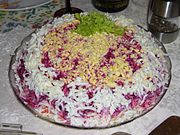Zakuski
 | |
| Course | Hors d'oeuvre or snack |
|---|---|
| Place of origin | Eurasia |
| Region or state | Eastern Europe, Northern Europe, Asia |
| Main ingredients | Cold cuts, cured fishes, mixed salads, pickled vegetables, kholodets, pirozhki, hard cheeses, caviar, roe, canapés, open sandwiches, breads |
Zakuski (plural from Russian: закуски [zɐˈkuskʲɪ]; singular zakuska from закуска) are an important part of Russian food culture and a term in many Slavic-speaking countries for cold hors d'oeuvres, entrées and snacks,[1][2] either as a course as it is or "intended to follow each shot of vodka or another alcoholic drink."[3] The word literally means something to bite after.[4] It probably originated and was influenced through the fusion of Slavic, Viking-Nordic and Oriental cultures in early Rus' regions like the Novgorod Republic.[5][6][7]
The tradition of zakuski is linked to the Swedish and Finnish brännvinsbord which was also the ancestor of modern smörgåsbord[2] and to meze of the Ottoman Empire and other Middle Eastern cultures.[8] Zakuski are not served as in Scandinavia at the buffet but on the dining table. Zakuski are also a food-in-itself and often not just served as starter to a meal. Zakuski were kept in the houses of the Russian gentry for feeding casual visitors who travelled long distances and whose arrival time was often unpredictable.[1] At banquets and parties, zakuski were often served in a separate room adjacent to the dining room or on a separate table in the dining room. The tradition eventually spread to other layers of society and remained in the Soviet times, but due to lack of space, they were served on the dinner table. Zakuski became thus the first course of a festive dinner.[2]
Nowadays, these appetizers are commonly served at banquets, dinners, parties and receptions in countries which were formerly part of the Russian Empire including some post-Soviet states and Poland (Polish: zakąski).[1][9] A broad selection of zakuski constitutes a standard first course at any feast table. Usually, zakuski are already laid on the table when guests are called to the dining room.[1]
Typical zakuski consist of cold cuts, cured fishes, mixed salads, kholodets (meat jelly), pirogs or pirozhki, various pickled vegetables such as tomatoes, beets, cucumbers, sauerkraut, pickled mushrooms, deviled eggs, hard cheeses, caviar, canapés, open sandwiches, and breads.[2][10]
Gallery
-
Pickled cucumbers as zakuska for clear vodka
-
Pirozhki, pickled tomato, mixed salads
-
Canapés with sprats
-
Breads with salo
-
Kolbasa (sausages)
See also
References
- ^ a b c d "Zakuski". Culture and Customs of Russia. Greenwood Publishing Group. 2000. ISBN 9780313311017.
- ^ a b c d Alan Davidson (2014). "Zakuski". The Oxford Companion to Food. Oxford: Oxford University Press. pp. 889–890. ISBN 9780191040726.
- ^ Encyclopaedia of Contemporary Russian
- ^ Закуска. С.И. Ожегов, Н.Ю. Шведова. Толковый словарь русского языка. Азъ, 1992 (in Russian)
- ^ Sharon, Hudgins (2018-05-15). T-bone whacks and caviar snacks : cooking with two Texans in Siberia and the Russian Far East. Hudgins, Tom. Denton, Texas. p. 18. ISBN 9781574417227. OCLC 1035845794.
{{cite book}}: CS1 maint: location missing publisher (link) - ^ "Food". Retrieved 7 November 2018.
- ^ Oliviu., Felecan (2013). Onomastics in Contemporary Public Space. Bughesiu, Alina. Newcastle upon Tyne: Cambridge Scholars Publishing. p. 340. ISBN 9781443852173. OCLC 861081474.
- ^ A., Wright, Clifford (2003). Little foods of the Mediterranean : 500 fabulous recipes for antipasti, tapas, hors d'oeuvre, meze, and more. Boston, MA: Harvard Common Press. ISBN 1558322272. OCLC 52514404.
{{cite book}}: CS1 maint: multiple names: authors list (link) - ^ Procner, Aleksandra (1999). Technologia gastronomiczna z towaroznawstwem [Gastronomic technology with commodity-knowledge] (in Polish). Warszawa: WSiP. ISBN 83-02-02789-8.
- ^ JOC All New Rev. - 1997 - Irma S. Rombauer, Marion Rombauer Becker










![Julienne [ru]](http://upload.wikimedia.org/wikipedia/commons/thumb/d/d3/Julienne.jpg/128px-Julienne.jpg)
![Squash spread [ru]](http://upload.wikimedia.org/wikipedia/commons/thumb/5/58/Squash_Caviar.jpg/180px-Squash_Caviar.jpg)
